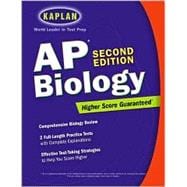"AP Biology, Second Edition" comes complete with a targeted review of biology, two full-length practice tests, plus Kaplan's renowned test-taking strategies. You'll get what you need to help you score higher on this challenging exam.
* In-depth review of all the material on the exam from the test prep experts
* Exclusive strategies to help you manage your time more effectivelyand successfully answer every question type
* Intensive practice for the exam with hundreds of practice questionsand detailed explanations for every answer
* A special glossary of biology terms to help you understand the key biological concepts that you'll see on the exam








